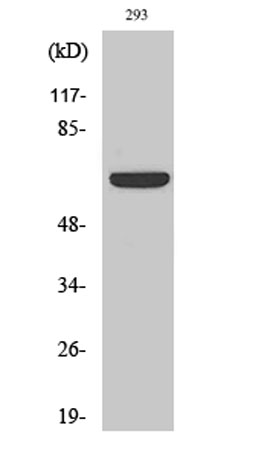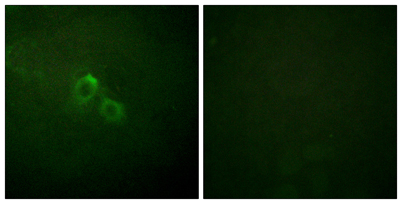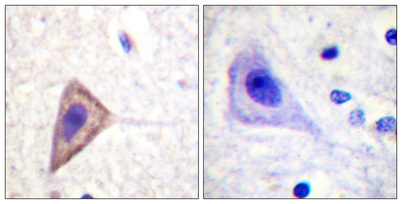Kv1.3 rabbit Polyclonal Antibody
| Cat Number: | ABE2687 |
|---|---|
| Conjugate: | unconjugated |
| Size: | 100 ug |
| Clone: | Polyclonal |
| Concentration: | 1 mg/ml |
| Host: | Rabbit |
| Isotype: | IgG |
| Immunogen: | The antiserum was produced against synthesized peptide derived from human Kv1.3/KCNA3. AA range:101-150 |
| Reactivity: | Human;Mouse;Rat |
| Applications: | Western Blot: 1/500 - 1/2000. Immunohistochemistry: 1/100 - 1/300. Immunofluorescence: 1/200 - 1/1000. ELISA: 1/20000. Not yet tested in other applications. |
| Purification: | The antibody was affinity-purified fromrabbit antiserum by affinity-chromatography using epitope-specific immunogen. |
| Synonyms: | KCNA3; HGK5; Potassium voltage-gated channel subfamily A member 3; HGK5; HLK3; HPCN3; Voltage-gated K(+) channel HuKIII; Voltage-gated potassium channel subunit Kv1.3 |
| Background: | Potassium channels represent the most complex class of voltage-gated ion channels from both functional and structural standpoints. Their diverse functions include regulating neurotransmitter release, heart rate, insulin secretion, neuronal excitability, epithelial electrolyte transport, smooth muscle contraction, and cell volume. Four sequence-related potassium channel genes – shaker, shaw, shab, and shal – have been identified in Drosophila, and each has been shown to have human homolog(s). This gene encodes a member of the potassium channel, voltage-gated, shaker-related subfamily. This member contains six membrane-spanning domains with a shaker-type repeat in the fourth segment. It belongs to the delayed rectifier class, members of which allow nerve cells to efficiently repolarize following an action potential. It plays an essential role in T-cell proliferation and |
| Form: | liquid |
| Buffer: | Liquid in PBS containing 50% glycerol, 0.5%BSAand0.02% sodium azide |
| Storage: | -20°C/1 year |

Western Blot analysis of various cells using Kv1.3 Polyclonal Antibody diluted at 1:500

Immunofluorescence analysis of HUVEC cells, using Kv1.3/KCNA3 Antibody. The picture on the right is blocked with the synthesized peptide.

Immunohistochemistry analysis of paraffin-embedded human brain tissue, using Kv1.3/KCNA3 Antibody. The picture on the right is blocked with the synthesized peptide.
